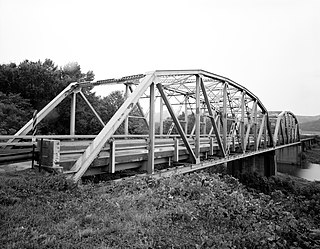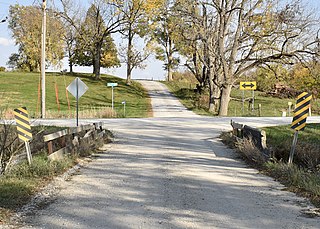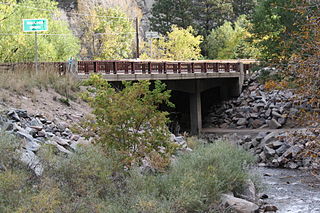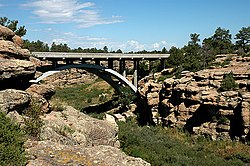
James Barney Marsh was an American engineer and bridge designer. He patented a new design for arch bridges. Marsh gave Archie Alexander, the first African-American to graduate as an engineer from Iowa State University, his first job. Marsh worked in the bridge building business for over 50 years, and several of his bridges are listed in the National Register of Historic Places.

The Lamar Boulevard Bridge is a historic arch bridge carrying Texas State Highway Loop 343 over Lady Bird Lake in downtown Austin, Texas, United States. The bridge features six open-spandrel concrete arches spanning 659 feet (201 m) and carries tens of thousands of vehicles daily across the lake. Completed in 1942, the Lamar Boulevard Bridge was the second permanent bridge to cross the Colorado River, and one of the last Art Deco-style open-spandrel concrete arch bridges built in Texas. The bridge was named an Austin Landmark in 1993 and added to the National Register of Historic Places in 1994.

The Black Squirrel Creek Bridge carries U.S. 24 over Black Squirrel Creek in El Paso County, Colorado. Prior to 2012, it was locally known as the "green bridge" or "old green bridge"—a historic single-span, Parker through truss bridge that was completed in 1935 and listed on the National Register of Historic Places in 2002. Because it no longer met highway safety standards, the bridge was dismantled and replaced by a newer span in 2012.

The Zion – Mount Carmel Highway is a 25-mile (40 km) long road in Washington and Kane counties in southern Utah, United States, that is listed on the National Register of Historic Places and is a National Historic Civil Engineering Landmark.

The Hayden Arch Bridge is a concrete arch bridge on old US 14/US 16 near Cody, Wyoming. It is the only example of its kind in Wyoming. Built in 1924–25, the single-span bridge spans 115 feet (35 m) with two smaller approach arches between rock canyon walls. The bridge carries the Cody-Yellowstone Highway across the Shoshone River with a shallow open-spandrel central arch and nominally arched approach spans. The bridge is named after C. E. Hayden, an engineer with the Wyoming State Highway Department, who designed the bridge and supervised its construction. It was built by H. S. Crocker of Denver, Colorado.

The Cove Creek Bridge is a historic bridge, carrying Arkansas Highway 309 across Cove Creek, south of the hamlet of Corley, Arkansas in the Ozark-St. Francis National Forest. It is a two-span closed-spandrel masonry arch structure, with each span measuring 13 feet (4.0 m) and an overall structure length of 26 feet (7.9 m). It is built entirely out of stone, with a concrete and asphalt deck, and concrete barriers at the sides. It was built in 1936 with funding support from the Works Progress Administration.

The US 41–Fanny Hooe Creek Bridge is a highway bridge located on US Highway 41 (US 41) over the Fanny Hooe Creek about one mile east of Copper Harbor, adjacent to Fort Wilkins State Park, in Grant Township, Michigan. It was listed on the National Register of Historic Places in 1999.

The Lee Creek Bridge in Natural Dam, Arkansas is a Pennsylvania through truss bridge that was built in 1934. It is a twin-span bridge with a total length of 587 feet (179 m), which carries Arkansas Highway 59 across Lee Creek. It rests on concrete piers and abutments, has a vertical clearance of 14 feet (4.3 m) and has a roadbed 22 feet (6.7 m) wide.

The Lincoln Highway Bridge is located in Tama, Iowa, United States, along the historic Lincoln Highway. The Steel stringer bridge was built in 1914, and it was listed on the National Register of Historic Places in 1978. It spans Mud Creek for 22 feet (6.7 m) with a width of 24 feet (7.3 m). The bridge is noteworthy for its distinctive railings. They are 3.33 feet (1.01 m) high, and feature the words "Lincoln Highway" in concrete. Local boosters of the Lincoln Highway paid for the railings as a way of promoting the roadway. The bridge was designed by the Iowa Highway Commission and built by Paul N. Kingsley, a contractor from Strawberry Point, Iowa.
Four historic bridges on the Big Thompson River in Larimer County, Colorado survived its flood of 1976, but since have lost most of their historic integrity. They were built in 1933 and 1937. All four were listed on the National Register of Historic Places in 2002, and two were delisted in 2010.

The Calamus Creek Bridge near Maxwell, Iowa is a concrete Luten arch bridge constructed in 1905. It was built by N. M. Stark and Company for a cost of $900. It has a 25-foot (7.6 m) single span and a total length of 45 feet (14 m).

The Plum Bush Creek Bridge, near Last Chance, Colorado, is a concrete rigid frame bridge that is listed on the National Register of Historic Places. It brings US 36 across Plum Bush Creek and is located at milepost 138.16 of US 36. It was designed by Colorado Department of Highways and built by Peter Kiewit Sons Construction Co. in 1938. It was listed on the National Register of Historic Places (NRHP) in 2002.

The West Plum Bush Creek Bridge, near Last Chance, Colorado, is a historic concrete rigid frame bridge that is listed on the National Register of Historic Places. Like the similar Plum Bush Creek Bridge less than four miles away, it brings U.S. Highway 36 across the Plum Bush Creek. It was designed by the Colorado Department of Highways and built by Peter Kiewit Sons Construction Co. It was listed on the National Register of Historic Places in 2002.

The San Luis Bridge, also known as State Bridge or Bridge over Culebra Creek, is a historic open spandrel arch bridge that crosses Culebra Creek in San Luis, Colorado. It was built in 1911 as a road bridge, but now serves pedestrian traffic. It is listed on the National Register of Historic Places.
Otter Creek Bridge is a historic structure located northwest of Oelwein, Iowa, United States. It spans Otter Creek for 86 feet (26 m). In July 1917, the Fayette County Board of Supervisors choose this bridge design for a concrete through girder bridge from the Iowa State Highway Commission, and put the project out to bid. When no one bid on the job they decided to use day laborers to build the bridge. It was completed later in 1917 for $5,153.88. The bridge was listed on the National Register of Historic Places in 1998.
Bad Route Creek Bridge is a historic bridge which carries County Road 261 across the Bad Route Creek in Dawson County, Montana. The Security Bridge Company built the bridge on behalf of the Montana Highway Department in 1921–22. The reinforced concrete bridge has six spans and is 98 feet (30 m) long, making it the longest concrete bridge built by the highway department. Neither the bridge company nor the highway department used concrete extensively, and most concrete bridges in the state only had one or two spans; as a result, the bridge is an unusual and well-preserved example of its type. The bridge was part of a route linking Glendive to Terry, which became part of U.S. Route 10 in 1926. US 10 bypassed the bridge when it was rebuilt in 1950.

The Herrold Bridge is a historic structure located near the unincorporated community of Herrold, Iowa, United States. It carried a gravel road for 156 feet (48 m) over Beaver Creek. Completed in 1921, this concrete cantilevered deck girder bridge replaced an earlier timber pile structure. It was designed by the Iowa State Highway Commission the previous year, and the Polk County Board of Supervisors awarded the construction contract to Ben Cole of Ames. The total cost of construction was $24,283.36. The bridge features three arched concrete deck girder spans that are cantilevered from concrete abutments and piers. It is considered one of the most technologically significant of Iowa's concrete girder bridges. The bridge was listed on the National Register of Historic Places in 1998. While it remains in place, the Herrold Bridge was replaced by a newer span slightly downstream.

The Bridge over Fountain Creek which was built to bring U.S. Route 24 (US 24) over Fountain Creek, approximately 0.5 miles (0.80 km) north of Manitou Springs, Colorado, was built in 1932. It now carries US 24 Business. It is an open spandrel deck arch span. It was listed on the National Register of Historic Places in 1985.

The Boulder Creek Bridge near Boulder, Colorado is a concrete slab and girder bridge which was built in 1953. It was listed on the National Register of Historic Places in 2003.

The North St. Vrain Creek Bridge, in Lyons, Colorado, was built in 1955. It was listed on the National Register of Historic Places in 2002.


















